Boeing 767

Boeing 767-300ER PH-OYI of TUI Netherlands taxiing at Amsterdam Schiphol.
Boeing 767
The Boeing 767 is a medium-range twinjet and the narrowest widebody airliner in service. Airlines fly several versions of the 767 on medium-range flights with 200 to 375 seats.
Boeing began making plans for a new commercial airplane in the early 1970s, when the 747 Jumbo Jet was still hardly operational yet. At that time Boeing built the 707, 727, 737 and 747. Among the first designs wearing a '767' designation was a four-engined more or less 727 look-alike in 1971. It had a T-tail, a highly swept wing, two engines at the rear of the fuselage and one engine under each wing. The idea was six-abreast seating with two aisles and a cruising speed of Mach 0.98. Because this is very close to the speed of sound, there was a Coca-Cola-bottle-like narrowing in the middle of the fuselage like many supersonic fighter aircraft had in these days. This narrowing was an application of the so-called 'area-rule' design principle, intended to compensate the increasing drag when approaching the speed of sound.

From 1972, many more studies followed under the preliminary designation '7X7'. The Italian company Aeritalia played an important role in these studies. An early 7X7 conceived by Boeing and Aeritalia together, had to become a short take-off and landing (STOL) airliner for regional flights. With its four engines, shoulder wing and T-tail, it much resembled the later British Aerospace BAe 146. However, the '7X7' was soon followed by designs for a widebody airliner with transcontinental-range, intended to replace 707s and 727s in high-density markets.
But Boeing was not in a hurry to develop such a new airliner, because around 1973, there was an upsurge in 727 orders. That gave the aircraft manufacturer extra time to consider many more designs. On the drawing boards appeared widebody jets with two engines ON the wing, with or without a third engine in the tail. Those were followed by twins with the engines under the wing and a conventional tail or 727-like T-tail. Boeing also studied three-engined models with a TriStar-like rear fuselage including one engine in the tail and two under the wing, also with a conventional tail or T-tail. Some designs featured fuselages offering seven-abreast seating, others, with a somewhat wider fuselage, an eight-abreast cabin layout.
 In 1976/1977, the 7X7 seemed to become a trijet (Image: Boeing) with an eight-abreast passenger cabin and a conventional tail or T-tail. At that time, the trijet was favourite, because it could fly long overwater sectors without restrictions, although Boeing also considered a 'twin first / tri-jet later' philosophy. In the meantime, in 1976, another Boeing design emerged, the 7N7, a narrowbody twin also aimed to replace 727s.
In 1976/1977, the 7X7 seemed to become a trijet (Image: Boeing) with an eight-abreast passenger cabin and a conventional tail or T-tail. At that time, the trijet was favourite, because it could fly long overwater sectors without restrictions, although Boeing also considered a 'twin first / tri-jet later' philosophy. In the meantime, in 1976, another Boeing design emerged, the 7N7, a narrowbody twin also aimed to replace 727s.
7X7 becomes 767
In January 1978, Boeing announced a major extension of its massive Everett 747-factory to accommodate the assembly line of the soon to be launched new widebody jet. In February, Boeing replaced the tentative '7X7' designator with '767' and planned three variants: the 767-100 (190 seats), the slightly bigger 767-200 (210 seats) and the 767-MR/LR (Medium Range / Long Range) 200-seat tri-jet. The latter was soon redesignated '777' and became an idea for later. The 767-100 was dropped as its capacity was too close to the 7N7, which became the 757.
 In the end, Boeing decided to go ahead with the 757-200 narrowbody and the 767-200 twinjet, with as many design features in common for both types as possible. United Airlines played a major role in the specifications of the final 767 design and it was no surprise that the US major became the first airline to order the new aircraft. After United signed an order for thirty aircraft, Boeing officially launched the 767, on July 14, 1978. Shortly before the launch, Boeing had abandoned the T-tail (Photo: Boeing) in favour of a conventional tail.
In the end, Boeing decided to go ahead with the 757-200 narrowbody and the 767-200 twinjet, with as many design features in common for both types as possible. United Airlines played a major role in the specifications of the final 767 design and it was no surprise that the US major became the first airline to order the new aircraft. After United signed an order for thirty aircraft, Boeing officially launched the 767, on July 14, 1978. Shortly before the launch, Boeing had abandoned the T-tail (Photo: Boeing) in favour of a conventional tail.
Cockpit
When the 767 was under development, there was much controversy about whether big planes should be flown by two pilots and a flight engineer or by just two pilots. Technology became more and more advanced and reliable and seemed to make the flight engineer superfluous. But flight engineers were fighting for their jobs, stating that a third pair of eyes in the cockpit was safer. At first, Boeing still offered the 767 with a third seat in the cockpit and United preferred a three-crew cockpit because of the risks involved with being launch customer. Boeing, in the meantime, was also developing a two-crew cockpit as an option for later customers. The smaller two-crew 737 showed, according to Boeing, that a two-member cockpit was even safer.
In July 1981, after extensive research and hearings, a special presidential task force in the US concluded that widebody aircraft with two-crew cockpits were safe. The task force announced this, however, one month before the official roll-out of the first 767 and with dozens of 767s with a three-crew cockpit already in production. Almost all airlines immediately wanted to convert their 767s ordered to be equipped with the two-crew flightdeck. It was quite a challenge for Boeing and its suppliers to adjust the production to the new cockpit concept at this stage of the 767 programme. In September 1981, Boeing decided to built the first thirty aircraft with the three-man cockpit and retrofit them with the new cockpit later. From the thirty-first aircraft, all 767s would be produced without a flight engineer position.
First flight
 So, the Boeing 767 made its first flight with a three-crew cockpit, on September 26, 1981(Photo: Boeing). The FAA certified the 767 on July 30, 1982. The first production aircraft was handed over to United Airlines in August 1982. United commenced commercial service with the three-crew 767 on September 8, 1982, on its Chicago to Denver route. Boeing delivered thirty three-crew 767s. Those aircraft were indeed converted later. The three-member cockpit remained an option, but no customer wanted it any more.
So, the Boeing 767 made its first flight with a three-crew cockpit, on September 26, 1981(Photo: Boeing). The FAA certified the 767 on July 30, 1982. The first production aircraft was handed over to United Airlines in August 1982. United commenced commercial service with the three-crew 767 on September 8, 1982, on its Chicago to Denver route. Boeing delivered thirty three-crew 767s. Those aircraft were indeed converted later. The three-member cockpit remained an option, but no customer wanted it any more.
The first two-crew 767 test-aircraft made its maiden flight on May 27, 1982, and the FAA certified it in March 1983. In the 767 'glass cockpit', there was a big role for computers to decrease workload. Much flight information was presented to the pilots on six cathode ray tube (CRT) displays instead of by mechanical instruments in earlier cockpits, including the horizontal situation indicator, and VHF and ILS information. Other important digital systems were the FMS (Flight Management System) and EICAS (Engine Indication and Crew Alert System).
Airbus A310
The 767's main competitor was the Airbus A310, which seated about the same number of passengers as the 767-200. The main difference between the two airliners was the fuselage diameter. The 767 allowed seven-abreast seating in the economy class (2-3-2), the A310 had an eight-abreast interior. By the way: charter airlines could squeeze eight-abreast seating into the 767 cabin, provided that the aircraft was fitted with double over-the-wing emergency exits.
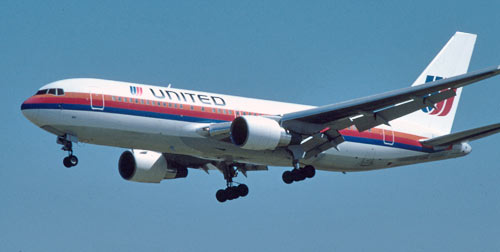 The height of the cargo hold is the same for both aircraft types, but because of its smaller diameter, the 767-fuselage is not wide enough to accommodate standard LD3 containers in two rows. LD3-containers are interchangeable with the A300, DC-10, TriStar and 747. For the 767 Boeing designed the non-standard LD67 container, which has the same height and width as the LD3 but is shorter and has less volume.
The height of the cargo hold is the same for both aircraft types, but because of its smaller diameter, the 767-fuselage is not wide enough to accommodate standard LD3 containers in two rows. LD3-containers are interchangeable with the A300, DC-10, TriStar and 747. For the 767 Boeing designed the non-standard LD67 container, which has the same height and width as the LD3 but is shorter and has less volume.
Large wing
Compared to the A310, the 767 has a rather big wing. The A310's wing was optimised for short-haul sectors in Europe. Therefore, it was designed as small as possible and fitted with several high-lift devices. The 767-200 had a rather big wing, breaking Boeing's tradition to fit airliners with a relatively small wing with many low-speed lift devices. Keeping a wing small is a good solution to keep weight and drag low. However, small wings restrict future developments. That is why Boeing launched the 767 with an even larger wing than that of the Airbus A300. It had bigger and heavier future versions in mind.
Engines
The first 767-200 was powered by two JT9D-7R engines, a 're-rated' version of the JT9D-versions used on the Boeing 747 and the McDonnell Douglas DC-10. The -7R is a lighter version with better specific fuel consumption. Later, the 767 became also available with the General Electric CF6-80 and when Boeing introduced the 767-300, with the Rolls-Royce RB.211-524 too.
In the 767, Boeing makes use of new stronger and corrosion resistant aluminium alloys. Kevlar is used in ailerons, elevators, rudder, spoilers, wing-fuselage fairing, undercarriage doors, cowling skins and the fixed parts of leading and trailing edge.
ETOPS
 After a good sales start, orders for the 767 tended to dry up. However, a real breakthrough for the 767 was the introduction of new so-called ETOPS-rules (Extended range Twin-engine Operational Performance Standards). According to old ICAO-rules dating from the piston age, twin-engined aircraft should never be farther away from a suitable airport to land than 90 minutes flying on one engine according. The FAA was even more strict with allowing only 60 minutes. Those rules made widebody twinjets very uneconomical on long overwater sectors. But because jet engines became more and more reliable, these rules were relaxed. In February 1985, the FAA allowed TWA to begin operating the 767 on its Boston-Paris route under a 75 minutes ETOPS rule. In May 1985, this was relaxed to 120 minutes, and later even to 180 minutes. The rules prescribed that aircraft used on ETOPS-flights met extra (safety) requirements for equipment, maintenance and flight procedures. ETOPS operations became very popular on long-haul routes for which aircraft like the 747 and the DC-10 were too big. In 1994, thanks to ETOPS, the 767 became the most widely used airliner on transatlantic crossings.
After a good sales start, orders for the 767 tended to dry up. However, a real breakthrough for the 767 was the introduction of new so-called ETOPS-rules (Extended range Twin-engine Operational Performance Standards). According to old ICAO-rules dating from the piston age, twin-engined aircraft should never be farther away from a suitable airport to land than 90 minutes flying on one engine according. The FAA was even more strict with allowing only 60 minutes. Those rules made widebody twinjets very uneconomical on long overwater sectors. But because jet engines became more and more reliable, these rules were relaxed. In February 1985, the FAA allowed TWA to begin operating the 767 on its Boston-Paris route under a 75 minutes ETOPS rule. In May 1985, this was relaxed to 120 minutes, and later even to 180 minutes. The rules prescribed that aircraft used on ETOPS-flights met extra (safety) requirements for equipment, maintenance and flight procedures. ETOPS operations became very popular on long-haul routes for which aircraft like the 747 and the DC-10 were too big. In 1994, thanks to ETOPS, the 767 became the most widely used airliner on transatlantic crossings.
Versions
767-200 and 767-200ER
Boeing developed a range of 767-versions, with three fuselage lengths. The Boeing 767-200 was the first and standard version. It seats 200-255 passengers, but a maximum of 275 seats is possible for charter airlines when extra overwing exits are installed.
The 767-200ER is an extended range version, with one or two extra fuel tanks in the center section of the fuselage, making TWA's transatlantic crossings possible. Boeing offered the 767-200ER to airlines from mid-1982 and it was first flown on March 6, 1984. The first production 767-200ER was delivered to El Al Israel Airlines on March 26, 1984. In 1988, the FAA certified a higher gross weight version of the -200ER with two extra fuel tanks and more powerful engines. This variant could fly a respectable distance of 12,133 km (6,550 nm).
Boeing ended production of the 767-200 and -200ER in 1994, but restarted building the 767-200ER in 1998 after an order from Continental Airlines for ten aircraft. Boeing delivered 128 767-200s and 121 767-200ERs.
767-300 and 767-300ER
 Boeing launched the stretched 767-300 in 1983 and the first airline to order it was Japan Airlines. The first flight was on January 30, 1986, and Boeing delivered the first production aircraft to Japan Airlines in September 1986. The 767-300 is 6.40 m (21 ft 1 in) longer than the 767-200. But actually, the 767-300 was not much more than a simple stretch of the 767-200ER. Apart from the fuselage plugs forward and behind the wing, Boeing didn't change much, so, because of the higher construction weight, the 767-300 had less range than the 767-200ER. Therefore it was soon followed by an extended range version, the 767-300ER, which flew for the first time on December 9, 1986, and was certified in late 1987. On March 3, 1988, the first 767-300ER entered into service with American Airlines. It offered a range of up to 11,100 km (6,000 nm).
Boeing launched the stretched 767-300 in 1983 and the first airline to order it was Japan Airlines. The first flight was on January 30, 1986, and Boeing delivered the first production aircraft to Japan Airlines in September 1986. The 767-300 is 6.40 m (21 ft 1 in) longer than the 767-200. But actually, the 767-300 was not much more than a simple stretch of the 767-200ER. Apart from the fuselage plugs forward and behind the wing, Boeing didn't change much, so, because of the higher construction weight, the 767-300 had less range than the 767-200ER. Therefore it was soon followed by an extended range version, the 767-300ER, which flew for the first time on December 9, 1986, and was certified in late 1987. On March 3, 1988, the first 767-300ER entered into service with American Airlines. It offered a range of up to 11,100 km (6,000 nm).
Thanks to an order from British Airways, the 767-300 was also offered with Rolls-Royce RB.211-524H engines. This variant was first flown on May 23, 1989, and the first delivery to BA took place in February 1990. Boeing built 104 767-300s and 583 767-300ERs.
767-300F Freighter
In January 1993, Boeing launched the 767-300F cargo version after UPS (United Parcel Service) ordered 30 aircraft and took options on 30 more. The 767-300F first flew in June 1995 and deliveries to UPS began in October 1995. As launch customer, UPS played an important role in the design process. This resulted in a wider cargo door, a rigid barrier between cockpit and cabin instead of traditional cargo nets, and extra facilities in the cockpit, like additional seats for the crew, a galley and a lavatory. The 767-300F is still in production and especially popular with small package companies like FedEx, UPS and Amazon's Prime. Demand increased because of an upsurge in the air cargo business during the corona pandemic in 2020 and 2021.
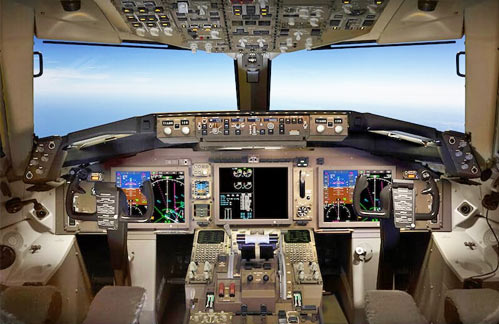 Later, UPS 767-300Fs were fitted with a new digital flightdeck, based on that of the 787. The six original CRT's of the earlier 767 cockpit were replaced with three much bigger and lighter 15.1 inch flat-panel screens. (Photo: Rockwell Collins) 767's already in service with UPS were retrofitted with the new cockpit.
Later, UPS 767-300Fs were fitted with a new digital flightdeck, based on that of the 787. The six original CRT's of the earlier 767 cockpit were replaced with three much bigger and lighter 15.1 inch flat-panel screens. (Photo: Rockwell Collins) 767's already in service with UPS were retrofitted with the new cockpit.
Boeing 767-400ER
In the 1990s, Boeing felt a gap in its portfolio between the 767-300ER and the new 777-200. To fill this gap, Boeing considered two options: a further stretch of the 767 beyond the 767-300ER or a smaller version of the 777, the 777-100. Boeing chose the first option and on April 28, 1997, officially launched the double-stretched 767-400ER, after a Delta Air Lines order for 21 aircraft. Continental Airlines soon followed with an order for 30. The 767-400ER's first flight was on October 9, 1999. Delta and Continental received their first aircraft in August 2000. Continental performed the first commercial flight on September 14, 2000.
 The 767-400ER is 6.43 m (21 ft 1 in) longer than the 767-300. It seats 245 passenger in a three-class layout and up to 350 in a one-class configuration (440 with extra emergency doors). The wing is extended with highly-swept raked wingtip extensions, adding 2.38 m (7.8 ft) to the span. The 767-400ER has a new cockpit with larger displays based on that of the 777. The new flightdeck became also available for new 767-300s and as a retrofit for earlier 767-200s and -300s. The interior is also in 777-style. The landing gear is 46 cm (18 in) higher than that of the 767-300 to prevent tailstrikes during take-off and landing, and it also has 777-like modified wheels and brakes. In spite of 'ER' in its designation, the 767-400ER offers less range than the 767-300ER (10,414 km / 5,625 nm).
The 767-400ER is 6.43 m (21 ft 1 in) longer than the 767-300. It seats 245 passenger in a three-class layout and up to 350 in a one-class configuration (440 with extra emergency doors). The wing is extended with highly-swept raked wingtip extensions, adding 2.38 m (7.8 ft) to the span. The 767-400ER has a new cockpit with larger displays based on that of the 777. The new flightdeck became also available for new 767-300s and as a retrofit for earlier 767-200s and -300s. The interior is also in 777-style. The landing gear is 46 cm (18 in) higher than that of the 767-300 to prevent tailstrikes during take-off and landing, and it also has 777-like modified wheels and brakes. In spite of 'ER' in its designation, the 767-400ER offers less range than the 767-300ER (10,414 km / 5,625 nm).
Failure
The 767-400ER was Boeing's answer to the Airbus A330-200 and was intended to replace ageing DC-10s, L-1011s and A300s. Boeing had high expectations and thought it could deliver up to about 900 aircraft. However, the 767-400ER became a big disappointment. Only 38 were built. Delta and Continental remained the only two airlines that ordered it. Continental even cut its order from 30 to 16 aircraft. The leasing companies ILFC and GECAS signed for five and three aircraft respectively, but because they couldn't find customers to lease the aircraft to, they switched their orders to other Boeing models. One aircraft was delivered as VIP aircraft to the Bahrain Royal Flight.
Boeing expected that airlines would be impressed by the the 767-400ER's low operating costs. But the 767-400ER arrived later on the market than the Airbus A330-200, and the Airbus offered more capacity and better performance. Boeing couldn't even convince 767-300ER users to buy the -400ER with the argument of standardisation. Many 767-300ER operators chose the A330-200 instead and sometimes even replaced 767s in their fleet with A330-200s. Boeing tried to repair the situation by proposing an improved variant, the 767-400ERX, with higher weights and more range. But this project depended on engines under development for a new proposed 747-version, the 747X. After the 747X was cancelled, engine manufacturers were not interested to develop their engines further for an uncertain project like the ERX. Only one airline ordered it: Kenya Airways signed for three aircraft but later switched to the 777. The -400ERX was never built.
Military versions
 Boeing developed several military versions of the 767, including an aerial tanker and transport aircraft based on the 767-200ER and in service in Italy and Japan as KC-767. Boeing also offered the aerial tanker to the US Air Force to replace the ageing Boeing KC-135 Stratotanker. At first the USAF selected the Airbus KC-30 instead, which was based on the A330-200, but later, the contest was reopened and in 2011, the order was rewarded to Boeing instead. The USAF version of the aircraft was then designated KC-46 Pegasus. (Photo: USAF)
Boeing developed several military versions of the 767, including an aerial tanker and transport aircraft based on the 767-200ER and in service in Italy and Japan as KC-767. Boeing also offered the aerial tanker to the US Air Force to replace the ageing Boeing KC-135 Stratotanker. At first the USAF selected the Airbus KC-30 instead, which was based on the A330-200, but later, the contest was reopened and in 2011, the order was rewarded to Boeing instead. The USAF version of the aircraft was then designated KC-46 Pegasus. (Photo: USAF)
Israeli Aerospace Industries (IAI) launched a programme to convert 767 airliners into aerial tankers as 767 MMTT (Multi Mission Tanker Transport). One 767-200ER conversion was carried out for the Colombian Air Force, which took delivery of the aircraft in 2010. The Brazilian Air Force ordered some conversions based on the 767-300ER.
E-767 AWACS
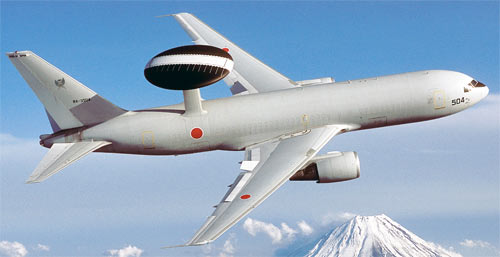 For Japan, Boeing developed an AWACS-version (Airborne Warning and Control System), the E-767, based on the 767-200ER airframe with a large rotating radar disk on top of the aft fuselage. Earlier AWACS aircraft were based on the 707, but in the 1990s, this aircraft type was not in production any more. The 767 had some advantages over the 707: a higher payload, more floor space and volume and greater range. The E-767 performed its maiden flight on August 9, 1997, and delivery of the first two of a total of four aircraft to the Japan Air Self-Defence Force took place in March 1998.
For Japan, Boeing developed an AWACS-version (Airborne Warning and Control System), the E-767, based on the 767-200ER airframe with a large rotating radar disk on top of the aft fuselage. Earlier AWACS aircraft were based on the 707, but in the 1990s, this aircraft type was not in production any more. The 767 had some advantages over the 707: a higher payload, more floor space and volume and greater range. The E-767 performed its maiden flight on August 9, 1997, and delivery of the first two of a total of four aircraft to the Japan Air Self-Defence Force took place in March 1998.
Boeing 767 AST
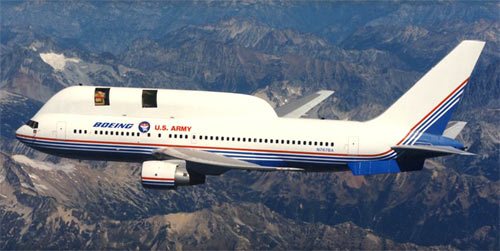 The US Army, Raytheon and Boeing modified the 767-200 testbed N767BA, the first 767 built, by installing infrared sensors that could detect and track intercontinental ballistic missiles (ICBMs), and later, short-range missiles too. The sensors were housed in the so-called 'copula', an 86 ft long hump on top of the fuselage behind the cockpit. The modification work began in late 1984 and the aircraft took off as '767 AST' (Airborne Surveillance Testbed) in August 1987. Since then, it took part in test and routine surveillance missions. It was withdrawn from use in 2003. Collected data were used in Boeing's missile programmes like the Delta II and Arrow. No more 767 ASTs were built.
The US Army, Raytheon and Boeing modified the 767-200 testbed N767BA, the first 767 built, by installing infrared sensors that could detect and track intercontinental ballistic missiles (ICBMs), and later, short-range missiles too. The sensors were housed in the so-called 'copula', an 86 ft long hump on top of the fuselage behind the cockpit. The modification work began in late 1984 and the aircraft took off as '767 AST' (Airborne Surveillance Testbed) in August 1987. Since then, it took part in test and routine surveillance missions. It was withdrawn from use in 2003. Collected data were used in Boeing's missile programmes like the Delta II and Arrow. No more 767 ASTs were built.
E-10A MC2A
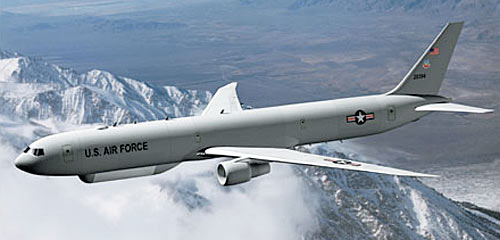 The US Air Force chose the 767-400ER as the platform for its E-10A MC2A (Multi-Sensor Command and Control Aircraft), intended to provide ground surveillance, cruise missile defense and battle management capability. It was to be equipped with a ground surveillance radar, advanced computers and battle management communications capability. The idea was to combine information from various sources into a complete real-time picture of ground battlefields. Initially, the E-10A was intended to replace the USAF's Boeing 707 based E-8C Joint Stars aircraft to provide improved tracking of moving ground targets. Additionally, it would be able to detect low-flying cruise missiles. Later considered derivatives were the E-10B to replace the USAF's Boeing E-3 AWACS airborne surveillance aircraft, and the E-10C to replace the RC-135 Rivet Joint signals intelligence aircraft. All these proposed versions could have resulted in production of up to 50 E-10 aircraft. However, when the first Boeing 767-400ER was on the assembly line as E-10 for delivery in July 2006, the project was cancelled. In the end, the single aircraft was delivered as 767-400ER VIP-aircraft to Bahrain's Royal Flight.
The US Air Force chose the 767-400ER as the platform for its E-10A MC2A (Multi-Sensor Command and Control Aircraft), intended to provide ground surveillance, cruise missile defense and battle management capability. It was to be equipped with a ground surveillance radar, advanced computers and battle management communications capability. The idea was to combine information from various sources into a complete real-time picture of ground battlefields. Initially, the E-10A was intended to replace the USAF's Boeing 707 based E-8C Joint Stars aircraft to provide improved tracking of moving ground targets. Additionally, it would be able to detect low-flying cruise missiles. Later considered derivatives were the E-10B to replace the USAF's Boeing E-3 AWACS airborne surveillance aircraft, and the E-10C to replace the RC-135 Rivet Joint signals intelligence aircraft. All these proposed versions could have resulted in production of up to 50 E-10 aircraft. However, when the first Boeing 767-400ER was on the assembly line as E-10 for delivery in July 2006, the project was cancelled. In the end, the single aircraft was delivered as 767-400ER VIP-aircraft to Bahrain's Royal Flight.
Sales
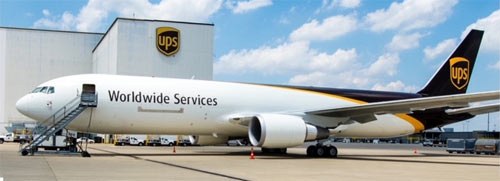 Boeing made a good sales start with the 767 in the late 1970s and early 1980s. At the time of the rollout on August 4, 1981, there were orders for 173 aircraft in Boeing's books. But during the next couple of years, orders were slow. From 1985, the sales improved a lot thanks to new versions like the 767-200ER, 767-300 and 767-300ER. In the first years of the new century, sales dried up again, and the end of the production seemed near. In 2007, however, there was a sudden revival of sales, including a big repeat order from UPS for 27 767-300F freighters. (Photo: UPS) During the corona pandemic in 1920-1922, Boeing also received substantial orders for the aircraft.
Boeing made a good sales start with the 767 in the late 1970s and early 1980s. At the time of the rollout on August 4, 1981, there were orders for 173 aircraft in Boeing's books. But during the next couple of years, orders were slow. From 1985, the sales improved a lot thanks to new versions like the 767-200ER, 767-300 and 767-300ER. In the first years of the new century, sales dried up again, and the end of the production seemed near. In 2007, however, there was a sudden revival of sales, including a big repeat order from UPS for 27 767-300F freighters. (Photo: UPS) During the corona pandemic in 1920-1922, Boeing also received substantial orders for the aircraft.
The 767 became the second widebody airliner to reach the 1000-aircraft mark, after the 747. The 1,000th 767 was rolled out from the assembly hall on February 2, 2011, a 767-300ER destined for All Nippon Airways (ANA). Today, it seems that the 767 line will keep running for quite some years to come producing freighters, and aerial tankers for the US Air Force. Until early 2022, Boeing has sold around 1,350 767s, including a backlog of more than one hundred. The 767's successor in Boeing's passenger aircraft catalogue is the 787 Dreamliner.
Boeing 767-200ER Specifications
 Wingspan: 47.57 m (156 ft 1 in). Length: 48.51 m (159 ft 2 in). Height: 15.85 m (52 ft).
Wingspan: 47.57 m (156 ft 1 in). Length: 48.51 m (159 ft 2 in). Height: 15.85 m (52 ft).
Empty weight: 82,380 kg (181,610 lb). Max. takeoff weight:
179,170 kg (395,000 lb).
Accommodation: 181-255 passengers. Range: 12,200 km (6,590 nm). Cruise speed:
851 km/h (459 kts). Engines: two General Electric CF6-80C2B (276 kN - 62,100 lb) or Pratt & Whitney PW4056 (282 kN - 63,300 lb).
Boeing 767-300ER Specifications
 Wingspan: 47.57 m 156 ft 1 in). Length: 54.94 m (180 ft 3 in). Height: 15.85 m (52 ft).
Wingspan: 47.57 m 156 ft 1 in). Length: 54.94 m (180 ft 3 in). Height: 15.85 m (52 ft).
Empty weight: 90,010 kg (198,440 lb). Max. takeoff weight:
186,880 kg (412,000 lb).
Passengers: 218-350. Range: 11,065 km (5,975 nm). Cruise speed: 851 km/u (459 kts). Engines: two GE CF6-80C2B (276 kN - 62,100 lb) or P&W PW4000 (282 kN - 63,300 lb) or Rolls-Royce RB211-524G/H 265 kN - 59,500 lb).
Boeing 767-400ER Specifications
 Wingspan: 51.92 m (170 ft 4 in). Length: 61.37 m (201 ft 4 in). Height: 16.80 m (55 ft 4 in).
Wingspan: 51.92 m (170 ft 4 in). Length: 61.37 m (201 ft 4 in). Height: 16.80 m (55 ft 4 in).
Empty weight: 103,870 kg (229,000 lb). Max. takeoff weight: 204,110 kg (450,000 lb).
Passengers: 245-375. Range: 10,415 km (5,625 nm). Cruise speed: 851 km/u (459 kts).
Engines: two General Electric CF6-80C2B (282.5 kN - 63,500 lb) or Pratt &Whitney PW4062 (280.9 kN - 63,140 lb).






















































